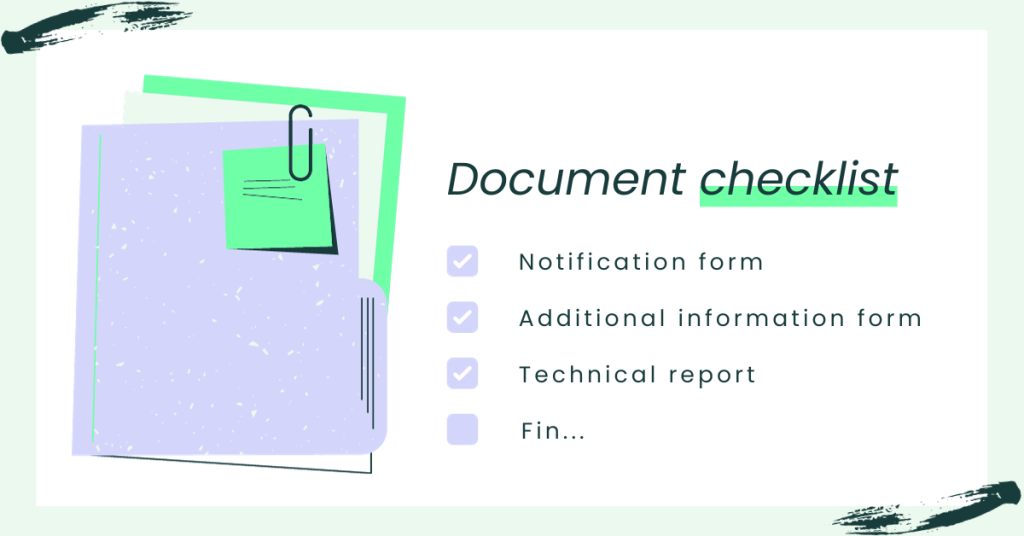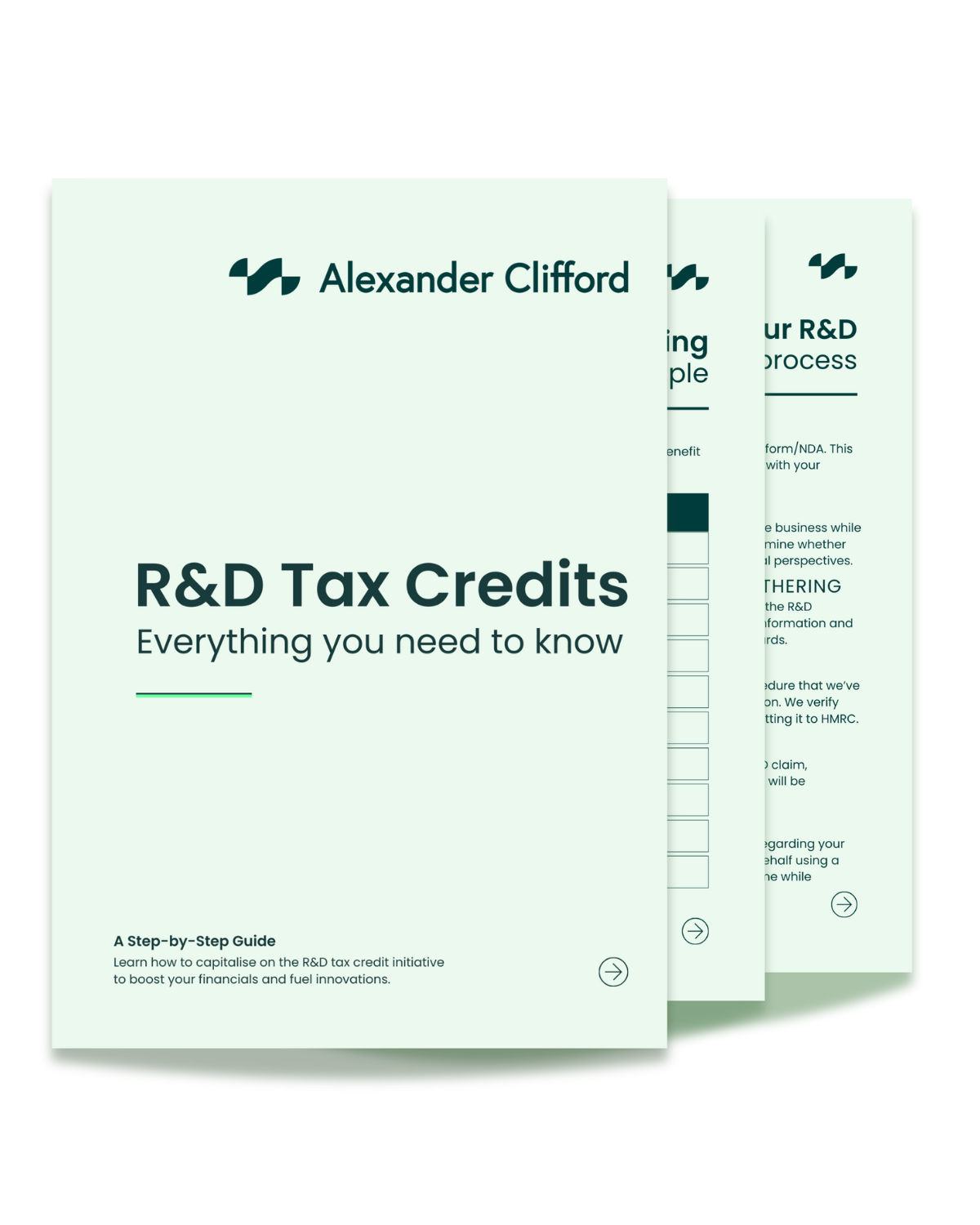Which documents are required for submitting an R&D claim?

Whether you’re a first-time R&D claimer, or you’ve previously claimed, it’s important to keep track of the latest regulations about the necessary documents for an R&D claim. The purpose of the documentation is to showcase your endeavours in contributing to the technological and scientific advancement in your industry. Listing the correct information about your trial and error attempts, and the costs involved, helps HMRC to reward you with the tax benefit you deserve for your endeavours. Let’s dive into the documentation you need for your upcoming R&D claim.
First-time claimants: The claim notification form
In the case of applying for R&D tax credits for the very first time, you need to inform HMRC in advance of the full claim through the claim notification form. You are responsible for notifying your claim, if:
- This is your initial claim.
- You claimed for the previous tax year, but you submitted the claim after the deadline of the claim notification period (which concludes 6 months after the end of the accounting period).
- Your last claim was lodged over 3 years before the final date of the claim notification period.
You must submit the claim notification form no later than 6 months after the conclusion of the relevant accounting period. Failing to meet this deadline will result in an invalid claim. You will need to provide the following information:
- The Unique Taxpayer Reference (UTR) of the company, must correspond to the one provided in your Company Tax Return.
- The primary senior internal contact within the company responsible for the R&D claim, such as a company director.
- The contact information of any agent involved in the R&D claim.
- The start and end dates of the accounting period for which you are claiming the tax relief or expenditure credit should match the dates indicated in your Company Tax Return.
- The start and end dates of the period of account.
- A brief overview of the planned high-level activities, such as the purpose of software development, to demonstrate that the project aligns with the standard definition of R&D. Please note that you do not need to include supporting evidence on the form, but you will be required to provide additional information on the supplementary form.
Existing claimants: An information form
From August 1st, 2023, HMRC requests an additional information form to support all your claims. This needs to be submitted first, before filing your corporate tax return (CT600). To fill out this form, you need the following information:
- Company details – You need to provide your Unique Taxpayer Reference (UTR), employer PAYE reference number, VAT registration number, and the classification code indicating your business type.
- Contact details – Information regarding any agent engaged in your R&D claim or the primary R&D contact within your team participating in the claim.
- Accounting period start and end date – The accounting period start and end dates you provide for claiming tax relief must align with the dates specified in your Company Tax Return.
- Details of qualifying expenditure – You need to detail your eligible costs such as staff PAYE costs/pension contributions, subcontractors’ costs, consumables, software purchases, travel costs, and utility bills.
- Details of your qualifying indirect activities – You’ll need to classify the amount of qualifying expenditure for each project of qualifying indirect activities that do not directly lead to resolving the uncertainty. This may include:
- Developing information services to support R&D, such as creating reports summarising R&D findings.
- Providing direct support activities for R&D, including maintenance, security, administration, clerical tasks, finance, and personnel activities that are specifically related to R&D.
- Undertaking ancillary activities necessary for initiating R&D, such as hiring and compensating staff, leasing laboratory facilities, and maintaining R&D equipment, including computers utilised for R&D purposes.
- Delivering training programs that directly support the R&D project.
- Conducting research carried out by students and researchers at universities.
- Performing research activities, including data collection, to develop new scientific or technological testing methods, surveys, or sampling techniques. Note that this research may not qualify as R&D on its own.
- Conducting feasibility studies that provide information to guide the strategic direction of a particular R&D endeavour.
- Project details – You are required to provide information about the total number of projects you are claiming for during the accounting period, along with their respective details. The specific requirements are as follows:
- If you are claiming for 1 to 3 projects, you must describe all the projects that encompass 100% of the qualifying expenditure.
- If you are claiming for 4 to 10 projects, you need to describe a minimum of 3 projects that account for at least 50% of the total expenditure.
- If you are claiming for 11 to 100 (or more) projects, you are required to provide details of the projects that represent a minimum of 50% of the total expenditure. At least 3 projects must be described. In cases where the qualifying expenditure is distributed among numerous smaller projects, you should provide information on the 10 largest projects.
- A description of each project – We have designed the following questions to determine your qualifying activities related to each project considering the eligibility criteria.
- What is the primary domain of science and technology?
- What was the initial level of scientific or technological knowledge that the company aimed to enhance?
- What specific progress or advancement in scientific or technological knowledge did the company strive to achieve?
- What were the uncertainties or unknowns encountered in the scientific or technological aspects of the project?
- How did your project intend to overcome these uncertainties?
- Which tax relief are you claiming, and what is the corresponding amount?
Other required documents for R&D claim
There isn’t an official list from HMRC, that details exactly the record system you need to claim for R&D tax credits. HMRC has an understanding that first-time claimants most likely don’t have all the relevant documentation in their first year. To prevent extensive enquiries into your claim, here’s what we recommend you include:
1. Technical documentation
This should encompass a comprehensive explanation of the R&D project, including its objectives, technical hurdles, and the measures taken to surmount them. This may entail project plans, design documents, test results, and technical reports.
2. Financial documentation
You must present evidence of the expenses incurred during the R&D project, which encompasses employee costs, subcontractor costs, materials costs, and other pertinent expenditures. This can involve invoices, timesheets, and receipts.
3. Corporate tax documentation
You are expected to provide information regarding the company’s corporate tax position, including tax returns, accounts, and tax computations.
4. Accounting documentation
Detailed accounting information must be provided to substantiate the claim, including general ledger accounts, trial balances, and profit and loss statements.
5. Payroll documentation
Payroll records for all employees involved in the R&D project, such as timesheets, salary and bonus details, and PAYE and NI contributions, should be submitted.
6. Statutory accounts
The most recent set of statutory accounts for the company, comprising the balance sheet, profit and loss account, and any associated notes, should be included.
7. Subcontractor agreements
If subcontractors were utilised during the R&D project, copies of their contracts and evidence of the payments made to them should be provided.
9. Technical review report
A technical review report summarising the R&D project, highlighting the technical advancements achieved, the technical challenges encountered, and the methods employed to overcome them, should be included.
10. Any other relevant documentation
Any additional pertinent documentation that you believe will support your R&D tax credit claim, such as research papers, conference papers, or any other relevant records associated with the R&D project, should also be submitted.
Making an R&D claim retrospectively
Naturally, if you’re not aware of what R&D tax credits are, you’re not going to gather all the relevant documents needed for your R&D claim. If you lack records and want to make an R&D claim, you can make reasonable estimates of your expenditure. Our R&D tax credit specialists can help you do this in accordance with HMRC’s standards. Book a free consultation now.
Best practices for R&D documentation
We’ve completed over 2400 claims for our clients across various industries. From our extensive experience, we’ve pulled together the following best practices for creating documents for R&D claim, so you can provide HMRC with everything they need to send you out your R&D benefit quickly.
Create detailed project records and store them in one location
Maintain detailed records of all R&D projects, including project plans, objectives, and timelines. Document the problem you’re trying to solve and how your R&D efforts are addressing it. Keep these located in one centralised place as opposed to being spread across different team members’ local drives, in long email chains, or written on pieces of paper.
Maintain a log of all expenses
Record and maintain logs of all expenses related to the R&D activities. This includes salaries, materials, equipment, and any other costs directly associated with the project.
Record the time spent by employees on R&D activities
With time tracking, you need to include not just researchers but also support staff who contribute to the project indirectly. This is important because you can only claim the proportion of staff wages that these staff directly work on R&D activities. There are various time tracking software on the market that can simplify time tracking for you.
Document the evolution of your project: The good, bad, and ugly
Maintain a project diary or log that chronicles the progress of the R&D project. Include details of any challenges faced and how they were overcome. Include all failures too, these are a testament to the fact you are contributing to overcoming uncertainty. This could be in the form of test results and incorrect design specifications, as two examples.
Don’t throw out evidence
If applicable, keep records of prototypes, models, or experimental setups. These can serve as tangible evidence of your R&D work.
Save all collaboration records
If you collaborate with external parties, keep records of agreements and communications. This includes any contracts or agreements with research partners or subcontractors.
Seek professional advice
If you’re unsure about any aspect of R&D documentation, seek advice from professionals who specialise in R&D tax incentives to ensure you’re fully compliant. We can take leadership of your documentation, on behalf of you, and complete a confident R&D claim with all supporting documents. Speak to us.
Final thoughts
By understanding what HMRC requires as part of your documents for an R&D claim and following these best practices for documenting your R&D activities and expenditures, you can strengthen your R&D claim and increase your chances of receiving the tax incentives you’re entitled to. The key to stress-free documentation is to keep all documentation updated regularly; it shouldn’t be an afterthought. Remember that each R&D claim may have specific requirements, so it’s essential to stay informed about the latest guidelines and regulations from HMRC.







